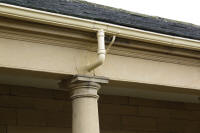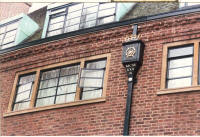|
Halifax-based Hargreaves Foundry, which has been manufacturing cast iron
since 1896 and now casts for celebrated sculptor Anthony Gormley, explains
how traditional foundry skills are preserving some of Britain’s finest
buildings for generations to come. |
| There
are just a handful of traditional foundries left in the UK – but those that
remain are playing a vital role in the restoration and preservation of
Britain’s finest period architecture. |
| The
surviving foundries possess the knowledge, skill and product range which can
turn even the most difficult-looking job into one of the most
straightforward elements of restoration. Designs that may seem hard to find
are actually part of the off-the-shelf range. |
|
Hargreaves Foundry, which was established in 1896 and is now the second
largest manufacturer in the UK, recently supplied more than 380 gutter
lengths and 110 rainwater pipes in the style of one of Yorkshire’s
most-loved heritage buildings from its off-the-peg range. |
| The immense Piece
Hall in Halifax, built in 1779 as a place for hand weavers to sell their
cloth, is now a shopping centre, entertainment venue and popular tourist
spot. |
 |
| At 6,500sqm, the
impressive Grade I listed building had moulded gutters which had to be
painted a specific sand colour that would match the building’s Yorkshire
stone. |
|
Calderdale Metropolitan Borough Council, which manages the building, was
able to replace the failing guttering and drainpipes from Hargreaves’s
standard product ranges. |
|
Sourcing replica cast iron guttering and pipe work isn’t as difficult as it
may seem when you know where to look, and neither is replacing more unusual
fittings on a large scale. |
| Clive
Gambrell, Hargreaves Foundry sales manager, said: “Cast iron is peculiar to
UK architecture and there are just three major manufacturers left here.
We’re the only ones that can deal in both volume and bespoke applications on
such a large scale. Hargreaves has now moved its entire UK production to
using only recycled or scrap iron and steel.” |
| He
describes a recent challenge to restore one of Cambridge University’s
college buildings, the Maufe building on St John’s College complex. |
|
“The building is distinctive. It was built in
the 1930s and has a very gentle curve to it. There was guttering and
pipework to both sides. This means that we had to produce convex guttering
and pipework for one side of the building and concave guttering and pipework
for the other. Not only that, but the original pipework had unusual
dimensions – 4.25x3.25in rather than the standard 4x3 inches.” |
| As the
architects wanted to reuse about half of the original gutters, fittings and
pipework, the replacement products had to match exactly the originals to
precise tolerance levels. |
| Hargreaves
executed the job with such precision, they were able to hand the
installation over to the University’s building maintenance division to slot
new straight into old. |
 |
| The new ironwork
also had to feature a decorative motif – a hallmark of the building. Clive
took a sample of the original guttering back to the foundry so the pattern
makers could reproduce the motif from the original. The replica ironwork is
almost indistinguishable from the originals. |
| Clive
explained: “The task of repairing and replacing historic cast iron windows,
pipes, guttering and other products can require skills as much akin to a
master detective as a master craftsman. |
| “The
loss, erosion and damage over scores of years can turn ornate cast iron into
irregular pieces of heavyweight jigsaw puzzles. When no original patterns
and no record of the original dimensions survive, there is rarely a
straightforward formula for 21st century replicas.” |
| In the
Cambridge project, Hargreaves’s expert cast iron detective team had more to
go on but it is not always the case. |
| At the
Garrison Chapel in Pembroke Dock, the only surviving Georgian classical
chapel in South Wales, Hargreaves were tasked with casting 11 new windows
using a clutch of clues, some comprising no more than fragile, slender
details, along with photographs of the original hopper-style openings.
|
| Now
in-situ and performing well in the restored church buildings, the cast iron
windows can be expected to provide up to a century of service, after which
all the castings can be fully recycled. |
|
Cast-iron production has changed very little over the last century.
Architects and specifiers are realising that this very traditional material
is one of the most environmentally sustainable products in the building
industry. |
| One
hundred per cent recyclable and with a life-expectancy of at least a
century, cast iron offers great green credentials, particularly when
compared with many modern alternatives. |
| For
further information on Hargreaves Foundry see
www.roofinfo.co.uk/hargreaves |